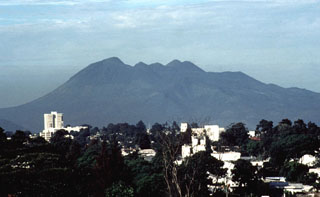Report on Pacaya (Guatemala) — April 1985
Scientific Event Alert Network Bulletin, vol. 10, no. 4 (April 1985)
Managing Editor: Lindsay McClelland.
Pacaya (Guatemala) Strombolian activity ejects scoria and Pele's Hair
Please cite this report as:
Global Volcanism Program, 1985. Report on Pacaya (Guatemala) (McClelland, L., ed.). Scientific Event Alert Network Bulletin, 10:4. Smithsonian Institution. https://doi.org/10.5479/si.GVP.SEAN198504-342110
Pacaya
Guatemala
14.382°N, 90.601°W; summit elev. 2569 m
All times are local (unless otherwise noted)
David Harlow climbed Pacaya during the night of 10 February and observed a slow-moving lava flow emerging from a vent between MacKenney Crater and the August 1984 lava NNE of the crater. When Enrique Molina and Randy White visited the volcano at the end of February, two vents were active in MacKenney Crater: the W vent had built a hornito and was spattering every second or two; only steam was emerging from the E vent, but it was glowing red at 6 m depth. By 17 March, a new cone over these vents had grown to 20 m height.
Enrique Molina and Michael Carr climbed Pacaya 24 April and observed continuing activity from the new cone. Small Strombolian explosions ejected tephra to 20 m height about every 7 minutes from one or both of a pair of vents 6-7 m apart. Activity was more vigorous from the W vent; only minor spattering occurred from the E vent. A steep lava tower, 3-4 m high, had grown over the E vent. Most of the ejecta were black scoria, as large as 1/3 m in diameter, that contained a few small plagioclase, olivine, and pyroxene phenocrysts. Considerable quantities of Pelé's Hair were found near the vents. The lava flow that was emerging from the E flank of the cone in February was no longer active. Farmers reported an active lava flow on the W flank of Pacaya, but the geologists did not visit the area.
Further Reference. Eggers, A.A., 1983, Temporal gravity and elevation changes at Pacaya volcano, Guatemala: JVGR, v. 19, p. 223-238.
Geological Summary. Eruptions from Pacaya are frequently visible from Guatemala City, the nation's capital. This complex basaltic volcano was constructed just outside the southern topographic rim of the 14 x 16 km Pleistocene Amatitlán caldera. A cluster of dacitic lava domes occupies the southern caldera floor. The post-caldera Pacaya massif includes the older Pacaya Viejo and Cerro Grande stratovolcanoes and the currently active Mackenney stratovolcano. Collapse of Pacaya Viejo between 600 and 1,500 years ago produced a debris-avalanche deposit that extends 25 km onto the Pacific coastal plain and left an arcuate scarp inside which the modern Pacaya volcano (Mackenney cone) grew. The NW-flank Cerro Chino crater was last active in the 19th century. During the past several decades, activity has consisted of frequent Strombolian eruptions with intermittent lava flow extrusion that has partially filled in the caldera moat and covered the flanks of Mackenney cone, punctuated by occasional larger explosive eruptions that partially destroy the summit.
Information Contacts: E. Molina, INSIVUMEH, Guatemala City; M. Carr, Rutgers Univ.; D. Harlow and R. White, USGS.

